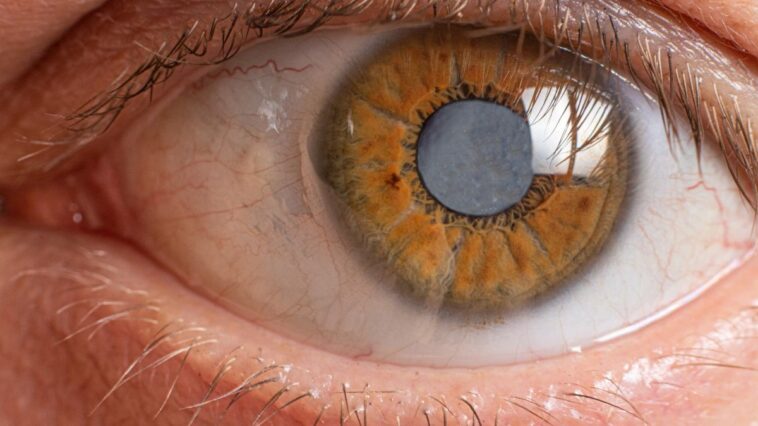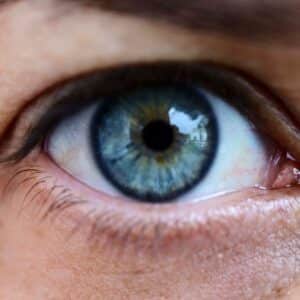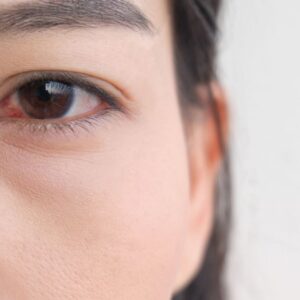What Are Cataracts?
Cataracts cloud the natural lens in the eye, which affects vision. The lens is located behind the iris and the pupil and is responsible for focusing light onto the retina at the back of the eye. When the lens becomes cloudy, it scatters light and causes vision to become blurred, hazy, or yellowed.
Cataracts are a common age-related condition, typically developing slowly over time. Other factors, such as injury, exposure to UV radiation, certain medical conditions, and certain medications, can also cause them.
Types of Cataracts
There are several different types of cataracts, each with distinct characteristics and causes. Some of the most common types of cataracts include:
- Age-related cataracts are the most common type caused by the natural aging process. As the lens of the eye ages, it becomes less flexible and more opaque, leading to the development of a cataract.
- Congenital cataracts are present at birth and can be caused by a genetic defect, an infection in the mother during pregnancy, or other factors.
- Traumatic cataracts: Traumatic cataracts can develop from injury to the eye, such as a blow to the head or a penetrating eye injury.
- Radiation cataracts: Exposure to high radiation levels, such as from X-rays or radiation therapy, can increase the risk of developing cataracts.
- Diabetic cataracts: People with diabetes have an increased risk of developing cataracts, which can be a complication of the disease.
- Secondary cataracts: Secondary cataracts can develop due to other eye conditions, such as uveitis or glaucoma.
The type of cataract a person has can affect the symptoms they experience and the best course of treatment. An eye doctor can diagnose the type of cataract a person has and develop an appropriate treatment plan.
What Are the Symptoms of Cataracts?
The symptoms of cataracts can vary, but common signs include the following:
- Blurred or hazy vision: Cataracts can cause your vision to become blurry or hazy, making it difficult to see clearly.
- Sensitivity to glare and bright lights: Cataracts can cause increased sensitivity to glare, making it difficult to see in bright light, such as during sunny days or driving.
- Double vision in one eye: In some cases, cataracts can cause double vision in one eye.
- Difficulty seeing at night: Cataracts can make it difficult to see, especially when driving.
- Frequent changes in eyeglass or contact lens prescription: If you’re experiencing frequent changes in your eyeglass or contact lens prescription, it may be a sign of cataracts.
- Yellowing of images: Cataracts can cause objects to appear yellowed or discolored.
If you notice any of these symptoms, you must see an eye doctor for a comprehensive exam. Timely detection and treatment of cataracts are essential as this can help protect vision and improve quality of life. Visit your eye doctor for a comprehensive exam if you have cataracts.
Causes of Cataracts
Cataracts can be caused by a variety of factors, including:
- Aging: As people age, one of the most common age-related eye issues is cataracts. Cataracts result from protein clumping in the eye lens, making it appear cloudy. Aging is the main contributor to this condition.
- UV radiation: Exposure to the sun’s ultraviolet (UV) radiation can increase the risk of developing cataracts.
- Medical conditions: Certain conditions, such as diabetes, can increase the risk of developing cataracts.
- Medications can be a risk factor for cataracts, particularly drugs such as corticosteroids. These medications may increase the chances of having cataracts, so it’s important to talk to your doctor if you have been prescribed such medications.
- Injury: Trauma or injury to the eye can cause cataracts to develop.
- Heredity: Cataracts can be passed down through families as a genetic trait.
- Lifestyle factors: Certain lifestyle factors, such as smoking, excessive alcohol consumption, and poor nutrition, can increase the risk of developing cataracts.
It’s essential to understand the causes of cataracts and to protect your eyes, such as wearing UV-protected sunglasses, maintaining a healthy diet, and avoiding smoking and excessive alcohol consumption. If you’re experiencing symptoms of cataracts, you must see an ophthalmologist for a comprehensive eye exam and discuss treatment options.
Diagnosis Of Cataracts
Cataracts are typically diagnosed during a comprehensive eye exam with an eye doctor. During the exam, the eye doctor will ask about your symptoms and medical history and perform a series of tests to evaluate your vision and eye health.
Tests that may be performed during a diagnosis of cataracts include:
- Visual acuity test: This test can assess the magnitude of vision impairment caused by cataracts. This test examines how well an individual can see things up close and at a distance.
- Slit-lamp exam: This exam uses a special microscope to examine the front and back of the eye, including the lens, to look for signs of cataracts.
- Dilated eye exam: The eye doctor will dilate your pupils and examine the inside of the eye, including the lens, to look for signs of cataracts.
- Tonometry: This test measures the pressure inside the eye to check for other eye problems that could affect vision, helping determine whether a cataract is present.
- Refraction test: This test helps determine the eyeglass prescription that will correct any vision problems caused by cataracts.
Based on the results of these tests, the eye doctor can diagnose cataracts and recommend a treatment plan, including cataract surgery if necessary. If you’re experiencing symptoms of cataracts, you must see an eye doctor for a comprehensive eye exam and discuss treatment options.
Treatment for Cataracts
The most common cataract treatment is surgery, which involves carefully removing the cloudy lens and replacing it with an artificial intraocular lens.
Cataract surgery is a standard and safe procedure that can significantly improve vision and quality of life.
The following are the steps involved in cataract surgery:
- Anesthesia: Cataract surgery is typically performed under local anesthesia, which numbs the eye, or topical anesthesia, which numbs the surface of the eye.
- Incision: The procedure involves the surgeon making a tiny incision in the eye to remove the cloudy lens.
- Removing the lens: The cloudy lens is carefully broken into pieces and removed using ultrasound technology.
- Inserting the artificial lens: An artificial lens, called an intraocular lens (IOL), is inserted into the eye to replace the removed lens.
- Closing the incision: The incision is closed without needing stitches, and the eye is covered with a protective shield.
After surgery, the eye may be sore and sensitive to light, but these symptoms typically improve within a few days. The eye doctor will provide instructions on how to care for the eye and manage any discomfort and when to return for follow-up exams to monitor healing and vision improvement.
In addition to surgery, other treatments for cataracts include:
- Wearing glasses or contacts to improve vision.
- Using bright lights or magnifying lenses to make reading easier.
- Avoiding bright lights and glare.
In some cases, cataracts may not yet affect vision enough to warrant surgery, and these other treatments may be sufficient.
If you’re experiencing symptoms of cataracts, you must see an eye specialist for a comprehensive eye exam and discuss treatment options that are right for you.
Preventing Cataracts
It is not possible to completely prevent getting cataracts. However, some actions can be taken to reduce the chances of developing them. These steps can help lower your risk of developing cataracts:
- Wear sunglasses: Wearing sunglasses that block ultraviolet (UV) rays can help reduce your risk of cataracts.
- Eat a healthy diet: Eating a nutritionally sound diet may help reduce the risk of developing cataracts. Antioxidants such as vitamins C and E and carotenoids can provide additional antioxidant protection, which could help lower your chances of cataracts.
- Don’t smoke: Avoiding smoking can help reduce the chance of developing cataracts and other eye conditions.
- Control medical conditions: Conditions such as diabetes, hypertension, and obesity can increase the risk of cataracts. Controlling these conditions through medication and lifestyle changes can help reduce the risk.
- Protect your eyes from the sun: Wearing a wide-brimmed hat or avoiding intense sun exposure during the middle of the day can help reduce your risk of cataracts.
- Regular eye exams: Regular eye exams can help detect cataracts early, before they affect your vision, and allow for prompt treatment.
Maintaining a healthy lifestyle, including exercise and a balanced diet, is vital to maintain good overall health and reducing the risk of cataracts and other eye diseases. If you’re concerned about your risk of cataracts, be sure to talk to your eye specialist about ways to reduce your risk and maintain good eye health.
After-Care for Cataract Treatments
After cataract surgery, following your eye doctor’s instructions for proper after-care after cataract surgery is vital to ensure a smooth recovery and the best possible outcome. Some general after-care instructions include:
- Protect the eye: Your eye doctor will provide a protective shield to wear over your eye for the first few days after surgery.
- Use eye drops: Your eye doctor may prescribe antibiotics, and anti-inflammatory eye drops to help prevent infection and reduce inflammation.
- Avoid touching or rubbing the eye: Touching or rubbing the eye can increase the risk of infection and affect the healing process.
- Limit physical activity: Avoid strenuous activities, such as heavy lifting or exercise, for the first few days after surgery to allow the eye to heal correctly.
- Attend follow-up appointments: Your eye doctor will schedule appointments to monitor your healing and vision improvement. It’s essential to attend these appointments as scheduled.
- Avoid swimming or soaking in water: Avoid submerging the eye, including swimming or soaking in a bath, for at least a week after surgery to reduce the risk of infection.
- Wear sunglasses: Wearing sunglasses can help reduce sensitivity to light and protect the eye from the sun’s harmful UV rays.
It’s also essential to monitor your vision and report any changes, such as pain, redness, increased light sensitivity, or blurry vision, to your eye doctor. Following these after-care instructions can help ensure a successful recovery and the best outcome from cataract surgery.
Conclusion
Cataracts are a common eye condition that affects millions of people all around the globe. This happens when the lens in the eye becomes cloudy, making vision blurred and difficult.
Symptoms of cataracts include double vision or blurred vision, increased sensitivity to light, and difficulty seeing at night.
Various risk factors could increase your chance of developing cataracts, including age, UV light exposure, smoking, excessive alcohol consumption, obesity, diabetes, family history, certain medications, and health conditions.
The primary treatment for cataracts is surgery to remove the affected lens and replace it with an artificial one.
Post-operative care is vital to ensure proper healing and minimize the risk of complications.
In addition to surgical treatment, reducing risk factors and undergoing regular eye exams can help prevent or delay the development of cataracts. Early diagnosis and treatment can help maintain good vision and improve quality of life.






